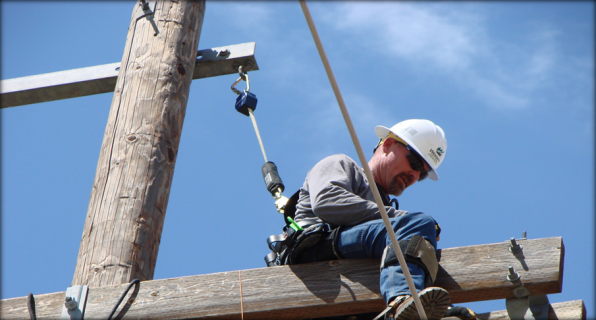November 30, 2017
Every year, the Occupational Safety and Health Administration (OSHA) releases a list of the top 10 most frequent workplace safety violations. OSHA shares this list to help you avoid the violations in your workplace and keep employees safe. Earlier this month, Texas Mutual reviewed OSHA's 2017 top 10 list in our policyholder webinar and discussed how to reduce your risk and maintain compliance. Our webinar includes visuals to help you understand these OSHA standards and the most common violations. You can watch the webinar here, or keep reading for a recap.
Each standard and its associated OSHA code are included below. The codes beginning with “1926” are standards specific to the construction industry, and those beginning with “1910” apply to other general industries.
 1 – Fall protection– OSHA wrote 6,072 citations in the construction industry for unprotected edges, open sides and failure to provide fall protection. To meet these requirements and keep employees safe, guardrails, safety nets or personal fall arrest systems must be used when an employee is working on an unprotected side or edge that is six feet or more above a lower level. OSHA code: 29 CFR 1926.501
1 – Fall protection– OSHA wrote 6,072 citations in the construction industry for unprotected edges, open sides and failure to provide fall protection. To meet these requirements and keep employees safe, guardrails, safety nets or personal fall arrest systems must be used when an employee is working on an unprotected side or edge that is six feet or more above a lower level. OSHA code: 29 CFR 1926.501
2- Hazard communication – Hazard communication came in second with 4,176 violations. The most frequent violations included lack of a hazard communication program, no safety data sheets, and not providing access to safety data sheets. Train your employees on your written hazard communications program to avoid these violations in your own workplace. Your employees should know where the safety data sheets are kept, as well as know how to read them and read chemical labels. OSHA code: 29 CFR 1910.1200
3- Scaffolding – There were 3,288 violations related to scaffolding in the construction industry. Improper access to surfaces and lack of guardrails were the most frequently violated requirements. Scaffolds must be designed by a qualified person and inspected daily. The scaffold needs to be used according to design and employees need to be trained on working safely on a scaffold. They must wear hardhats if the scaffold is 10 feet or higher. OSHA code: 29 CFR 1926.451
4 – Respiratory protection – Coming in at number four is respiratory protection, with 3,097 violations for failure to establish a respiratory protection program or failure to provide medical evaluations. To reduce the risk of receiving a citation from OSHA, employers should have a written respiratory protection program. A respiratory protection program will establish practices and procedures for respirator use including guidelines for training, selection, proper storage, use and care of respirators. Fit testing and medical evaluations should be included in your respiratory protection program. OSHA code: 29 CFR 1910.134
5 – Lockout/tagout – The lockout/tagout standard was cited 2,877 times, with the most frequent violations for inadequate worker training and missing or incomplete inspections. Lockout/tagout should take place whenever the servicing or maintenance of machines happens. You should have documentation for this procedure covering the steps to turn off, de-energize, lock and tag machinery while servicing it, keeping the machinery in a de-energized state to avoid an unexpected start up. OSHA code: 29 CFR 1910.147
6 – Ladders – Ladder standards were cited 2,241 times in the construction industry for improper use, damaged ladders, and the use of the top step. To avoid this violation in your workplace, make sure you and employees always choose the proper ladder for the job. Consider the height of the work, the surface the ladder will rest on, whether or not electricity will be involved, and what the maximum intended load will be when selecting the ladder.
Employees should be trained on how to inspect ladders before each use to avoid using a damaged ladder. Damaged ladders should be labeled “Do Not Use” and should be removed from use. When using a ladder, always face forward using the three-point contact rule, and do not stand on the top rung of the ladder. OSHA code: 29 CFR 1926.1053
7 – Powered industrial trucks – The powered industrial trucks regulation was cited 2,162 times. The most frequently violated requirements included inadequate worker training, as well as inadequate refresher training. Power industrial trucks include forklifts, tractors, platform lift trucks, motorized hand trucks and other specialized industrial trucks.
Employees must be given formal instruction, practical training and an evaluation of the operator’s performance in the workplace. This training must be conducted by someone who has knowledge, training and experience to train employees and evaluate their competence. Retraining is required for situations following an accident, or if the vehicle is seen being used in an unsafe manner. OSHA code: CFR 1910.178
8 – Machine guarding – This general industry citation was given 1,933 times for instances of no machine guards and exposure to points of operation. Machine guarding must be used to prevent the operator and other employees in the area from hazards created by the point of operation, nip points, rotating parts, flying chips, and sparks. The point of operation is the area on a machine where the work is performed on the material being processed. The guard must not create any new hazards or interfere with the standard operations of the machine. OSHA code: 29 CFR 1910.212
9 – Fall protection – training requirements – This standard, which was cited 1,523 times, is new to the OSHA top 10 list and is specific to the construction industry. The most common violations were failing to train workers on identifying fall hazards and failure to train them on the proper use of fall protection equipment. To avoid this violation at your workplace, employees should be trained in a language they understand. Training should cover recognizing the hazards of falling and how to minimize those hazards with different types of fall protection. Employees should also know how to inspect their fall protection equipment. OSHA code: 1926.503

10 – Electrical-wiring methods– With 1,405 violations, electrical-wiring methods was number 10 on the list of the most-commonly cited OSHA standards in 2017. OSHA found boxes not covered correctly and too many or overloaded wires as the most frequent offenses. Any conductors entering boxes must be protected from abrasion and any unused opening must be effectively closed. Additionally, boxes must be fitted with a cover identified for the purpose. Conductors should also be protected against overheating due to motor overloads. OSHA code: 29 CFR 1910.305
Texas Mutual policyholders can access resources to help avoid these violations by logging into texasmutual.com and clicking the Safety tab. Our resource center includes a sample respiratory protection program, lockout/tagout e-Learning training and ladder safety posters in multiple languages, among thousands of other resources. Additionally, our safety services support center can help you to identify hazards in your workplace to help you stay off OSHA’s radar. Call 844-WORKSAFE (967-5723) to speak to a safety services specialist.